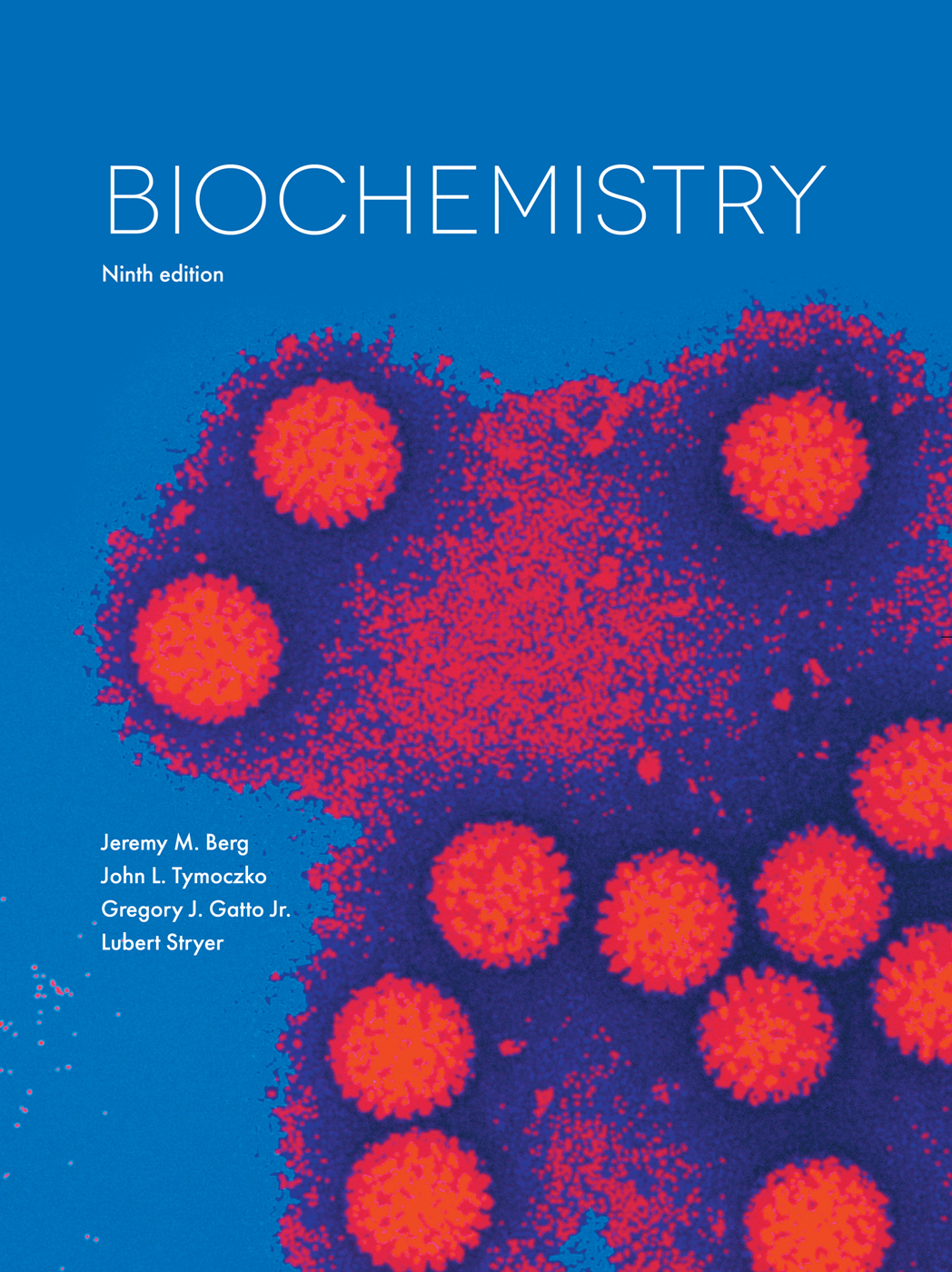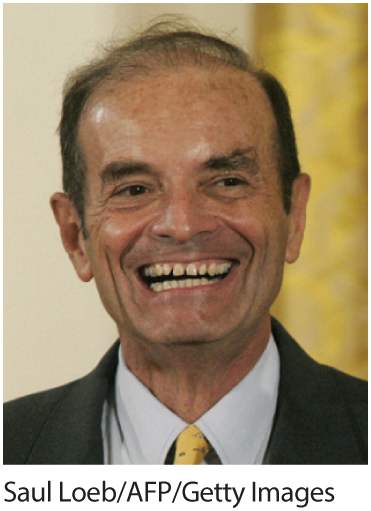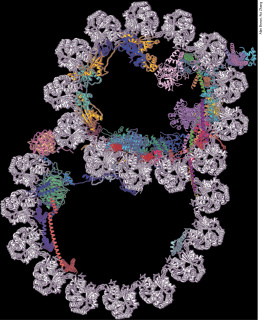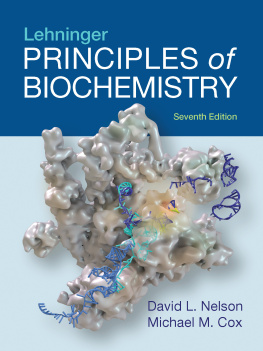Contents
Landmarks

The front cover shows an illustration of a molecular structure.
BIOCHEMISTRY
NINTH EDITION
- Jeremy M. Berg
- John L. Tymoczko
- Gregory J. Gatto, Jr.
- Lubert Stryer

VICE PRESIDENT, STEM: Daryl Fox
EXECUTIVE PROGRAM DIRECTOR: Sandy Lindelof
EXECUTIVE EDITOR, LIFE SCIENCES: Lauren Schultz
MARKETING MANAGER: Maureen Rachford
DIRECTOR OF DEVELOPMENT, STEM: Lisa Samols
DEVELOPMENTAL EDITORS: Lisa Bess Kramer and Michael Zierler
EDITORIAL ASSISTANT: Justin Jones
DIRECTOR OF CONTENT MANAGEMENT ENHANCEMENT: Tracey Kuehn
SENIOR MANAGING EDITOR: Lisa Kinne
SENIOR CONTENT PROJECT MANAGER: Peter Jacoby
SCHEDULE MANAGER: Karen Misler
SENIOR WORKFLOW PROJECT MANAGER: Paul W. Rohloff
PRODUCTION SUPERVISOR: Jose Olivera
DIRECTOR OF CONTENT: Jennifer Driscoll Hollis
CONTENT DEVELOPMENT MANAGER: Amber Jonker
LEAD CONTENT DEVELOPERS: Angela Piotrowski and Cassandra Korsvik
MEDIA EDITOR: Jennifer Compton
MEDIA PROJECT MANAGER: Daniel Comstock
PROJECT MANAGEMENT: Lumina Datamatics, Inc.
COMPOSITION: Lumina Datamatics, Inc.
ILLUSTRATIONS: Jeremy Berg with Network Graphics, Gregory J. Gatto, Jr., Adam Steinberg
ILLUSTRATION COORDINATORS: Janice Donnola and Emiko Paul
PHOTO PERMISSIONS EDITOR: Christine Buese
PHOTO RESEARCHER: Jennifer Atkins
DIRECTOR OF DESIGN, CONTENT MANAGEMENT: Diana Blume
DESIGN SERVICES MANAGER: Natasha Wolfe
INTERIOR DESIGN: Marsha Cohen
Gregory J. Gatto, Jr., is an employee of GlaxoSmithKline (GSK), which has not supported or funded this work in any way. Any views expressed herein do not necessarily represent the views of GSK.
ISBN: 978-1-319-24806-2 (epub)
2019, 2015, 2012, 2007, by W. H. Freeman and Company; 1995, 1988, 1981, 1975 by Lubert Stryer
All rights reserved
1 2 3 4 5 6 23 22 21 20 19 18
W. H. Freeman and Company
One New York Plaza
Suite 4500
New York, NY 10004-1562
www.macmillanlearning.com
To our teachers and our students
ABOUT THE AUTHORS

JEREMY M. BERG received his B.S. and M.S. degrees in Chemistry from Stanford University (where he did research with Keith Hodgson and Lubert Stryer) and his Ph.D. in Chemistry from Harvard with Richard Holm. He then completed a postdoctoral fellowship with Carl Pabo in Biophysics at Johns Hopkins University School of Medicine. He was an Assistant Professor in the Department of Chemistry at Johns Hopkins from 1986 to 1990. He then moved to Johns Hopkins University School of Medicine as Professor and Director of the Department of Biophysics and Biophysical Chemistry, where he remained until 2003. He then became Director of the National Institute of General Medical Sciences at the National Institutes of Health. In 2011, he moved to the University of Pittsburgh where he is now Professor of Computational and Systems Biology and Pittsburgh Foundation Chair and Director of the Institute for Personalized Medicine. He served as President of the American Society for Biochemistry and Molecular Biology from 20112013. He is a Fellow of the American Association for the Advancement of Science and a member of the Institute of Medicine of the National Academy of Sciences. He received the American Chemical Society Award in Pure Chemistry (1994) and the Eli Lilly Award for Fundamental Research in Biological Chemistry (1995), was named Maryland Outstanding Young Scientist of the Year (1995), received the Harrison Howe Award (1997), and received public service awards from the Biophysical Society, the American Society for Biochemistry and Molecular Biology, the American Chemical Society, and the American Society for Cell Biology. He also received numerous teaching awards, including the W. Barry Wood Teaching Award (selected by medical students), the Graduate Student Teaching Award, and the Professors Teaching Award for the Preclinical Sciences. He is coauthor, with Stephen J. Lippard, of the textbook Principles of Bioinorganic Chemistry. Since 2016, he has been Editor-in-Chief for Science magazine and the Science family of journals.

JOHN L. TYMOCZKO is Towsley Professor of Biology Emeritus at Carleton College, where he has taught since 1976. He taught a variety of courses including Biochemistry, Biochemistry Laboratory, Oncogenes and the Molecular Biology of Cancer, and Exercise Biochemistry, and cotaught an introductory course, Energy Flow in Biological Systems. Professor Tymoczko received his B.A. from the University of Chicago in 1970 and his Ph.D. in Biochemistry from the University of Chicago with Shutsung Liao at the Ben May Institute for Cancer Research. He then had a postdoctoral position with Hewson Swift of the Department of Biology at the University of Chicago. The focus of his research has been on steroid receptors, ribonucleoprotein particles, and proteolytic processing enzymes.

GREGORY J. GATTO, JR., received his A.B. degree in Chemistry from Princeton University, where he worked with Martin F. Semmelhack and was awarded the Everett S. Wallis Prize in Organic Chemistry. In 2003, he received his M.D. and Ph.D. degrees from the Johns Hopkins University School of Medicine, where he studied the structural biology of peroxisomal targeting signal recognition with Jeremy M. Berg and received the Michael A. Shanoff Young Investigator Research Award. He completed a postdoctoral fellowship in 2006 with Christopher T. Walsh at Harvard Medical School, where he studied the biosynthesis of the macrolide immunosuppressants. Dr. Gatto is currently a Scientific Leader and GSK Fellow in the Target Incubator Discovery Performance Unit at GlaxoSmithKline. While he enjoys losing at board games, attempting but not completing crossword puzzles, and watching baseball games at every available opportunity, he treasures most the time he spends with his wife Megan and sons Timothy and Mark.

LUBERT STRYER is Winzer Professor of Cell Biology, Emeritus, in the School of Medicine and Professor of Neurobiology, Emeritus, at Stanford University, where he has been on the faculty since 1976. He received his M.D. from Harvard Medical School. Professor Stryer has received many awards for his research on the interplay of light and life, including the Eli Lilly Award for Fundamental Research in Biological Chemistry, the Distinguished Inventors Award of the Intellectual Property Owners Association, and election to the National Academy of Sciences and the American Philosophical Society. He was awarded the National Medal of Science in 2006. The publication of his first edition of










